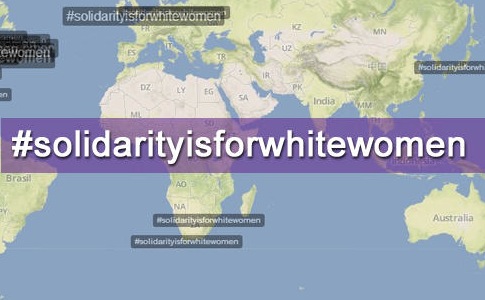On Monday, the Twitter universe exploded in a hashtag controversy that pulled in feminists of all races and genders. The hashtag #solidarityisforwhitewomen started in a “moment of frustration” by Mikki Kendall as self-described male feminist Hugo Schwyzer targeted feminists of colour for standing in his way.
For some background, Schwyzer is a Pasadena College professor of History and Gender Studies, who among other things, is known for attempting to murder his girlfriend, and a recent sexting saga with a porn star. As divisive as he may be, Schwyzer has sway in the feminist blogosphere, specifically with affluent White women.
The hashtag #solidarityisforwhitewomen intended to call out Schwyzer’s abusive comments, but the ensuing conversation has exposed many truths about the way discussions around gender are framed in the media, and how a new breed of digital feminism, in particular, is watering down the multiple struggles that feminist discourse is meant to encompass. The women that Schwyzer aligns himself with dominate the public (read: digital) space, take over talk show segments and comment at length on their ideology with little concern for the issues that affect communities of colour, or people of varying socio-economic classes.
This, at the crux, is what underlies the #solidarityisforwhitewomen hashtag and the subsequent dialogue. #Solidarityisforwhitewomen compelled reactions from every spectrum — some were defensive and angry, others shared personal anecdotes and were reflective. When a woman of colour claims that “solidarity is for white women” she is not decrying the actual, real and pertinent issues that feminists across races take under their wing, but rather, how much certain voices capitalize on their dominance of the public/digital sphere. In doing so, these voices take over the conversation and articulate struggles that are selective and often patronizing.
There is a consistent feeling that White women feminists do not understand issues around communities of colour. The climax came at the acquittal of George Zimmerman last month, which involved six women jurors, five of whom were white. These were women who, for many, reinforced the perception that some feel that a Black child deserves to be gunned down if he is perceived as a threat to a majority white community. They were the ones who largely stayed silent when #Justice4Trayvon took over as a Twitter trend.
As a woman of colour, I sometimes feel a double bind, taking on battles on two fronts. On a diminutive level, when I am told to “Lean In”, and how as a woman, “I still can’t have it all” — I listen, but I don’t feel heard. On the other end, I struggle with convincing my own community that we need to discuss misogyny more openly, and doing so does not implicate me in any form of Western conspiracy.
Within communities of colour, women or men who may identify as “feminist” — no matter how flexible the attachment — are often condemned for taking on a cause that does not represent their issues. This might be a result of systems of patriarchy within these communities that can reinforce that feminism is not for “their daughters.” More likely, the resentment and detachment is evoked through seeing feminists obsessed with liberating women through how they dress, sanctioning war, protecting their children from people of different races, or disregarding the struggles of an undocumented worker striving to support her family on a minimum wage job.
Furthermore, this hesitation is a byproduct of years of mistrust on the part of communities of colour for being consistently scapegoated for their religious and ethnic backgrounds. How can they forget the prominent White women and self-identifying feminists at the forefront supporting the NATO invasion of Afghanistan and Iraq a decade ago? Similarly, the protests organized by FEMEN that aim to “liberate” Muslim women from religious clothing fail to contextualize that what you wear is not a source of oppression, but being systematically excluded from economic employment due to this same prejudice can be.
I’ve been involved in foreign aid funded initiatives to train on gender rights in developing countries, met with equal hesitation and a sense that we are imposing Western concepts that are not relevant to local lives and struggles. The understanding of feminism here is a school of thought positioned firmly in a Western context. This disconnect continues despite research finding that the most important and consistent factor driving policy change in countries across the world is local feminist activism — the type we likely don’t hear about on the news.
These are the reasons #solidarityisforwhitewomen is an important first step towards a needed conversation. Modern feminism may have come of age in White-dominant, Western contexts, but it was always meant to work at the juncture of critical discourse — incorporating class, race and gender analysis.
Within a populist, digital realm, however, it’s depicted to the favour of a few, and increasingly being distanced from those who need it the most to strengthen their movements and be shown solidarity in that respect.



